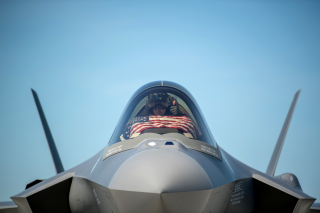Stealth Warrior: Is the F-35 Being Used To Its Full Potential?
Gen. Kenneth S. Wilsbach, who spoke at an AFA Mitchell Institute virtual event this week, said that the United States Air Force has continued to make a crucial mistake with the F-35 jet. Instead of taking full advantage of the airframe’s fifth-generation stealth and sensor fusion capabilities, the aircraft was being operated little differently than the F-15C or F-22.
Here's What You Need To Remember: As more F-35s enter service and more partners adopt the aircraft there is no doubt going to be a learning curve, but no one said flying the most advanced aircraft in the world would be easy.
The Lockheed Martin F-35 Lightning II Joint Strike Fighter was designed to serve as a multirole fighter that could perform air superiority and strike missions, while also providing electronic warfare and intelligence, surveillance and reconnaissance to friendly forces. It is no secret that in addition to being the most expensive weapon program in military history, the F-35 jet has had more than a few problems in its development.
In fact, the bugs are still being worked out and according to recent reports won’t even enter full production until at least next year.
However, some military leaders have also suggested that the aircraft isn’t even being used as intended. Gen. Kenneth S. Wilsbach, who spoke at an AFA Mitchell Institute virtual event this week, said that the United States Air Force has continued to make a crucial mistake with the F-35 jet. Instead of taking full advantage of the airframe’s fifth-generation stealth and sensor fusion capabilities, the aircraft was being operated little differently than the F-15C or F-22.
According to a report in Air Force Magazine, Wilsbach has criticized the Air Force’s handling of the F-35 jet, but said that while it took a while to address the learning curve and operators need to understand that “the tactics are completely different.” The Pacific Air Forces commander also offered advice to U.S. partners that are also operating the F-35 jet and suggested it be used “like an F-35” rather than treating the aircraft as if it is a fourth-generation fighter.
Wilsbach suggested that more emphasis needs to be placed on the aircraft’s stealth abilities, but also the weapons that can be deployed on the F-35 jet.
Advice Heeded
That advice has reportedly resonated with operators, and currently, the U.S. has F-35 jet exchange programs with pilots from Australia, Japan and South Korea learning the ropes with the fifth-generation stealth aircraft at Luke Air Force Base, Arizona.
While the majority of Australia’s F-35As, along with pilots, maintainers and aircraft have returned to the Royal Australian Air Force Base Williamtown in New South Wales, Australia, the RAAF still maintains a joint pilot training and maintenance presence at Luke. U.S. Air Force pilots are also learning something from the joint training.
“I feel like we contribute something to the U.S. Air Force training mission by bringing our own unique perspectives, configuration, roles and environments to the mission, just like the U.S. Air Force mission brings that to us as well,” suggested RAAF Maj. Christopher Baker, 61st Fighter Squadron instructor pilot and graduate of the F-35A pilot training program at Luke AFB. In addition to training the Australian pilots to get the most of the F-35, it has been noted that it also helps fulfill Secretary of Defense Mark Esper’s national defense priority of strengthening alliances and partnerships.
In addition to U.S. Air Force pilots training alongside partners with the F-35A, United States Marine Corps pilots have been training with the UK pilots of the Royal Air Force and preparing for carrier operations with the F-35B version, which is being deployed on the Royal Navy’s flagship aircraft carrier HMS Queen Elizabeth.
As more F-35s enter service and more partners adopt the aircraft there is no doubt going to be a learning curve, but no one said flying the most advanced aircraft in the world would be easy.
Peter Suciu is a Michigan-based writer who has contributed to more than four dozen magazines, newspapers and websites. He is the author of several books on military headgear including A Gallery of Military Headdress, which is available on Amazon.com. This article was originally published last month.
Image: Reuters.

